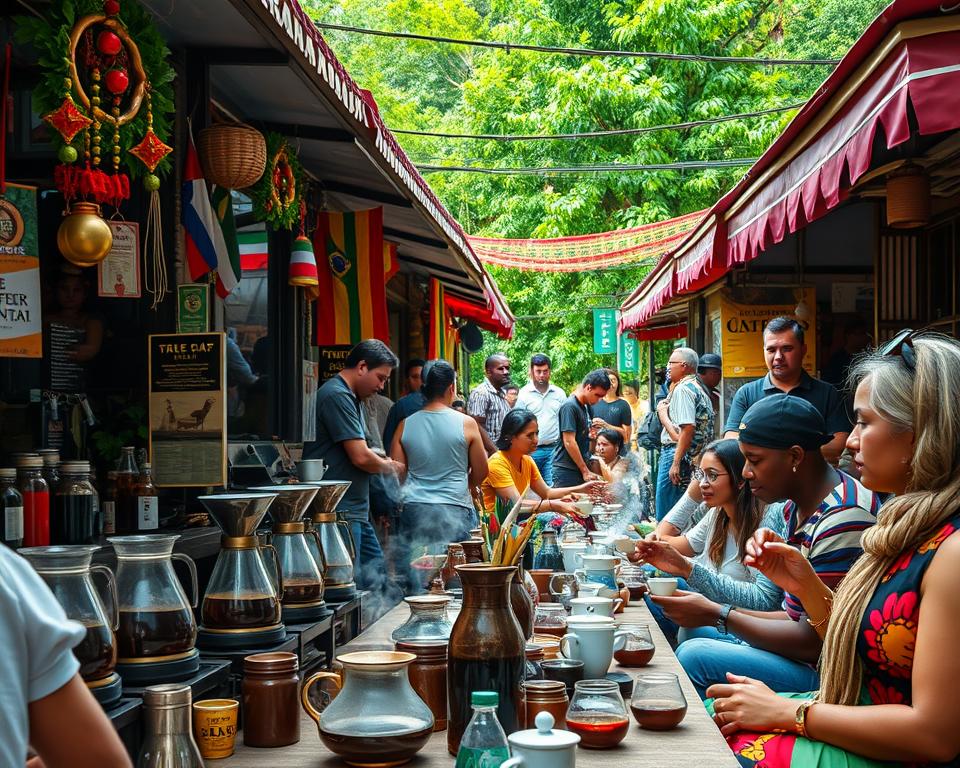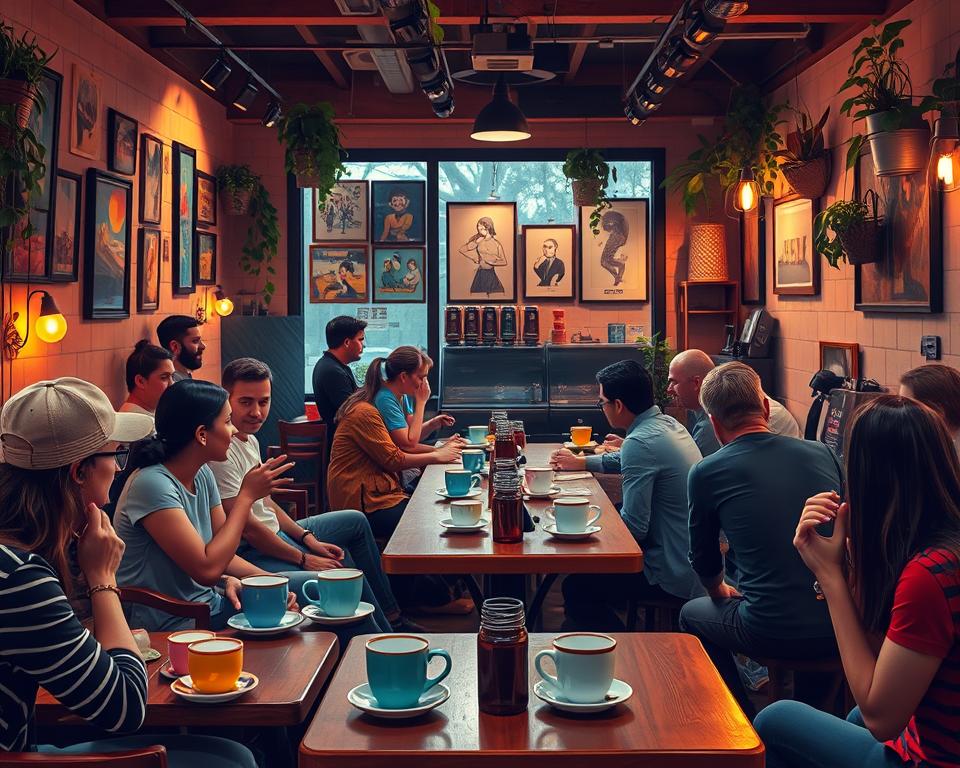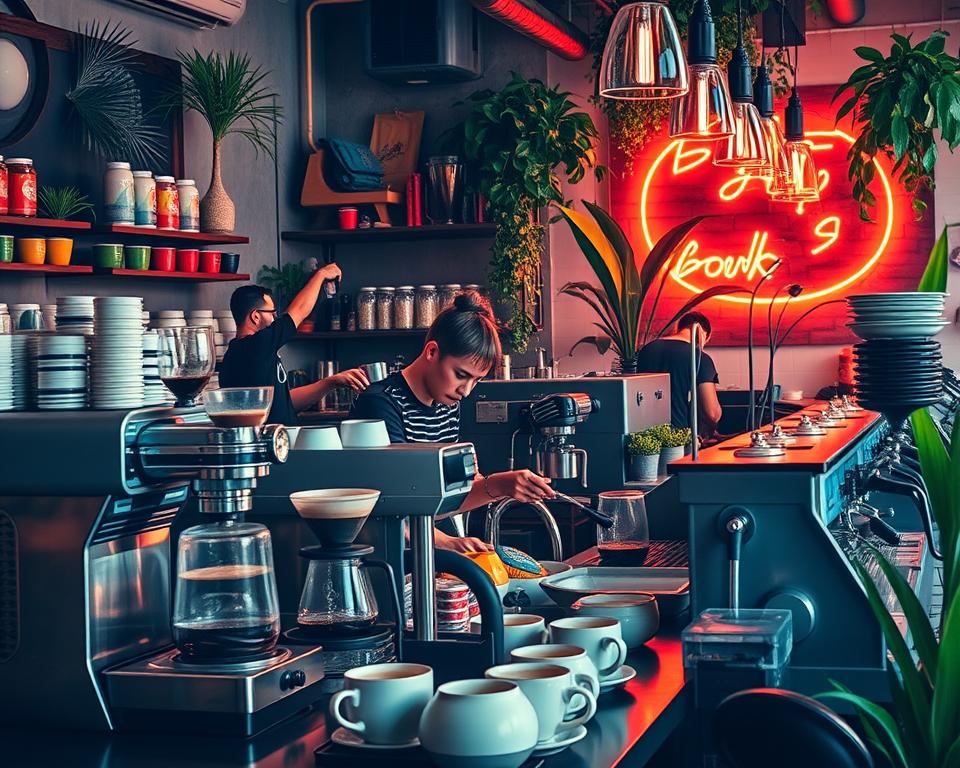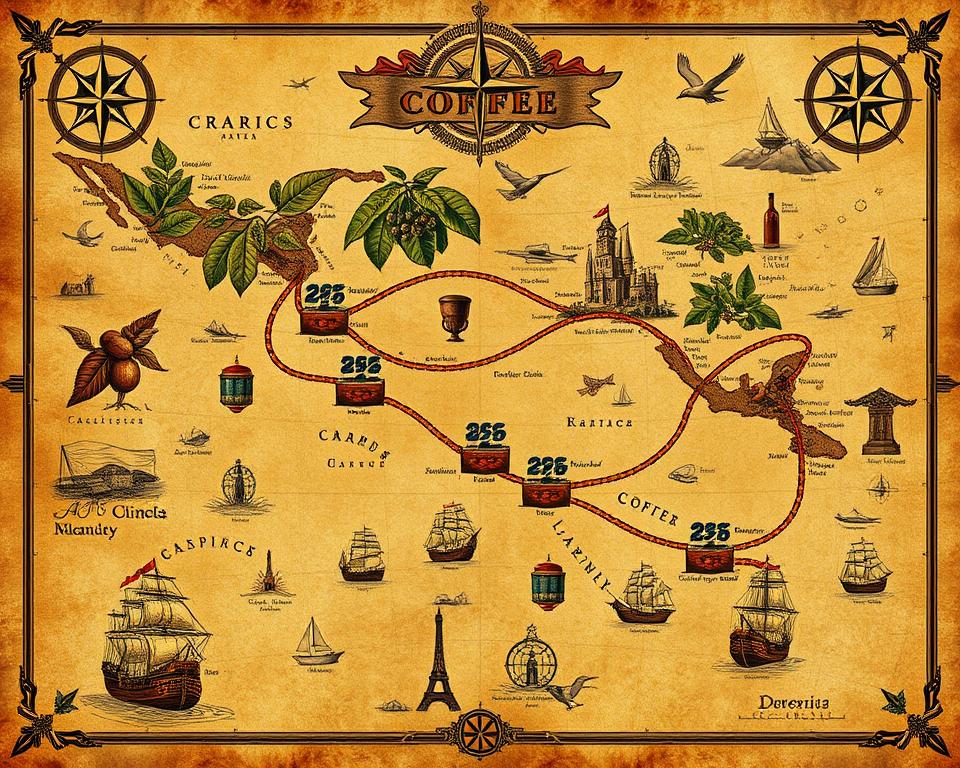Journeying through global coffee traditions uncovers the wide range of cultural coffee experiences across the globe. From Italy’s bustling cafés to Ethiopia’s detailed coffee ceremonies, each practice offers a peek into different regional values and social norms.
In Italy, espresso isn’t just a beverage; it’s a vital part of daily life that brings people together. Turkish coffee, known for its strong flavor and sweetness, is steeped in culture. It often includes tasseography—a practice of predicting the future by reading coffee grounds.
The Ethiopian coffee ceremony, called Buna, is a shared experience that emphasizes unity and cultural heritage. Over in Vietnam, egg coffee is a creative mix of coffee and egg yolks, blending tradition and innovation. Colombia and Brazil showcase their love for coffee through farm-to-cup experiences and the cafézinho culture, which offers a taste of their hospitality.
Exploring global coffee practices and rituals lets us appreciate their distinct flavors and the cultural meanings they hold. Let’s dive into the unique art and traditions that define coffee as both a global and intimately local phenomenon.
Italy: Espresso Elegance
Italian espresso culture is rich in tradition and quality. It is enjoyed everywhere in Italy. From home with a Moka pot to 150,000 coffee bars, it’s key to Italian life. Let’s explore the world of espresso and morning cappuccinos. We’ll also look at the coffee etiquette that makes this experience special.
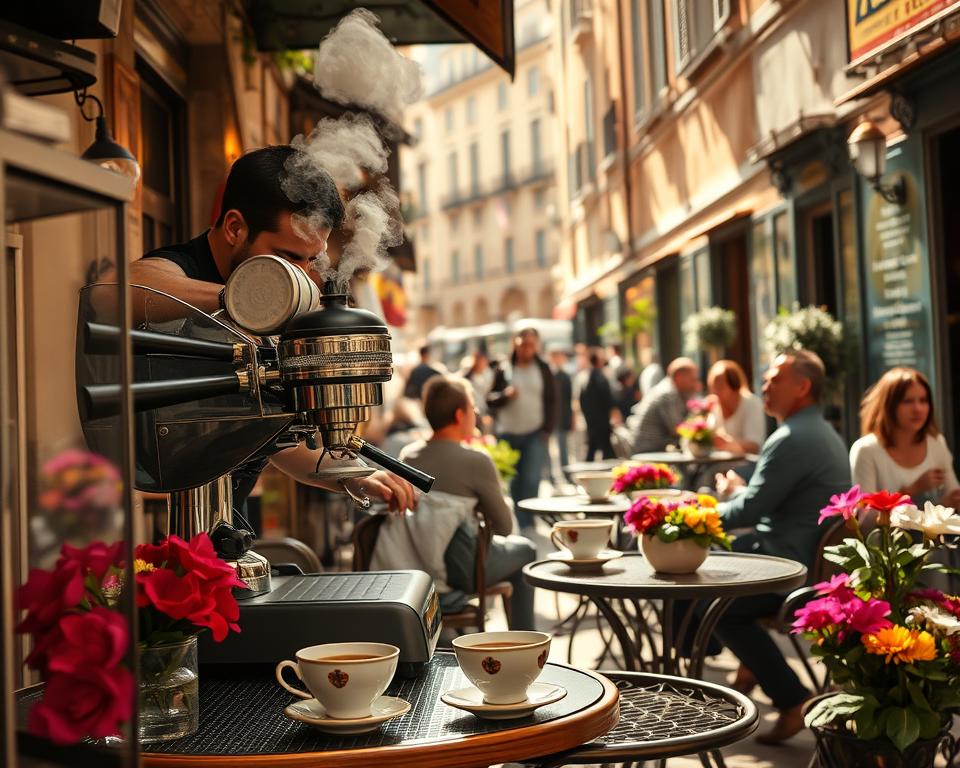
The Importance of Espresso
Espresso in Italy is more than a drink; it’s a coffee craftsmanship symbol. This small, strong coffee shot is deeply cherished. Italians drink about 4.79 kg of coffee each, mostly espresso. It’s loved at any hour and varies regionally. From Naples’ robust espressos to Milan’s lighter roasts, it shows Italy’s coffee diversity.
Morning Rituals with Cappuccino
Cappuccino mornings are a treasured ritual in Italy. It’s drunk in the morning, before 11 a.m., following tradition. The mix of espresso, milk, and foam makes it perfect with a light breakfast and a cornetto. It’s not just about the drink. It’s about community and starting the day together.
Read more on the heartwarmingbenefits of coffee here
Coffee Etiquette in Italy
Knowing Italian coffee etiquette is key to enjoying espresso culture. There are unwritten rules to follow:
- Always drink your espresso quickly, in about 2 minutes, for its best taste.
- It’s normal to stand at the bar, which often costs less than sitting.
- Never order a cappuccino after morning; it’s only for the start of the day.
- Stick to standard coffee sizes here. It’s about the quality, not how much.
- Talking with the barista and others is common, as coffee bars are for socializing.
These traditions show that coffee in Italy is more than a drink. It’s about savoring the moment and connecting with people, true to Italy’s espresso elegance.
Turkey: Strong and Sweet
Making Turkish coffee is a cherished tradition from the 15th century Ottoman Empire. It’s a key part of Turkey’s culture, blending social customs with history. We’ll look at how it’s made and its importance in society.
Traditional Turkish Coffee Preparation
To make traditional Turkish coffee, finely ground beans are simmered with sugar and sometimes spices in a cezve. The slow brewing process blends the flavors well, creating a strong, foamy drink. This technique is a significant part of Turkish culture.
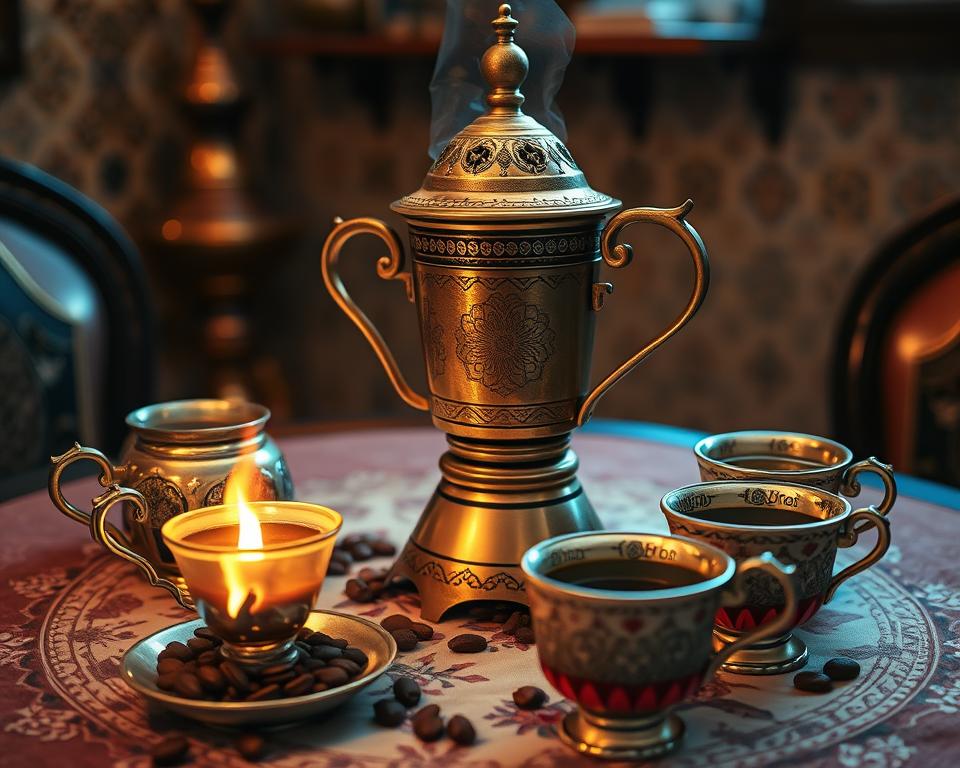
You can choose how sweet you want your Turkish coffee. Options range from unsweetened to very sweet. Flavors like cardamom or ambergris can be added too.
The Cultural Significance of Turkish Coffee
Turkish coffee symbolizes friendship, respect, and hospitality. It’s essential at home and in social events. It’s also key in customs, like marriage proposals, showing its deep cultural role.
At Turkish weddings, the bride-to-be serves coffee to the groom and guests. This tradition shows the deep history of Turkish coffee. The groom’s response to the coffee can even test his character.
Reading fortunes from coffee grounds is a beloved Turkish custom. It remains a fun part of social life.
In 2013, UNESCO recognized Turkish coffee’s preparation method as a cultural heritage. This highlighted its global significance. Today, coffeehouses around the world serve Turkish coffee, showing its wide appeal.
Modern tools, like the SAKI Turkish coffee maker, keep the tradition alive conveniently. Even Starbucks in Turkey offers Turkish coffee, proving its ongoing popularity.
Coffee Traditions Around the World
Exploring coffee traditions around the globe reveals their cultural importance. We’ll dive into some notable coffee customs together. These highlight community, creativity, and heritage beautifully.
Ethiopian Coffee Ceremony
Ethiopia is often called coffee’s birthplace. Here, Ethiopian coffee ceremonies are a cherished ritual. It’s a shared experience that involves roasting, grinding, and brewing fresh beans meticulously. This ceremony is all about hospitality and connecting people, with every detail carefully performed.
Vietnam’s Egg Coffee and Drip Filter
Vietnamese coffee culture is known for its innovative Vietnamese egg coffee. Made with robusta beans, egg yolk, and condensed milk, it’s smooth and creamy. Traditional drip filters enhance this unique drink, complementing the strong aroma of Vietnamese coffee. This ingenuity, born from wartime scarcity, continues to please people today.
Colombia’s Farm-to-Cup Experience
Colombia is famous for its coffee. It offers incredible Colombia coffee tours for a complete farm-to-cup journey. On these tours, you visit lush coffee farms to see coffee’s cultivation, harvesting, and processing. This provides a tasty brew that captures Colombia’s coffee culture. The tours focus on sustainable, quality coffee production.
Brazil’s Cafézinho Culture
Brazil is a coffee powerhouse, integrating coffee into daily life with its cafezinho tradition. This small, sweet cup of coffee is a gesture of hospitality. It symbolizes the warmth and friendliness of Brazilian society. More than just a drink, it’s key to Brazilian social life.
Japan: Precision and Elegance in a Cup
Japan’s coffee culture is unique in its focus on detail and standards. It goes from Japanese pour-over coffee to fun themed cafes. There’s a clear commitment to doing things perfectly and creatively.
Pour-Over Method
The Japanese pour-over method, using tools like the Hario V60, brings out the best coffee flavors. This technique is key to Japan’s third-wave coffee scene. It stresses the importance of good beans and exact methods.
Unique Themed Cafes
Japan’s themed cafes provide a one-of-a-kind coffee experience. They combine the country’s creative spirit with its coffee love. From places filled with animals to ones inspired by movies, they make visits unforgettable.
The Third-Wave Coffee Movement
The third-wave coffee movement in Japan is about artisan coffee places. It focuses on uniqueness and knowing where the coffee comes from. Shops like Blue Bottle Coffee and Kurasu are growing. They show Japan’s dedication to coffee quality and new ideas. For more on coffee, read this interesting comparison.
How Does Middle Eastern Coffee Culture Fit Into Global Coffee Traditions?
Middle Eastern coffee culture, rich in rituals and flavors, offers a unique perspective within the global coffee landscape. Through distinct brewing methods and communal gatherings, coffee becomes a symbol of hospitality and tradition. To truly appreciate its depth, one must take the time to explore the heritage of middle eastern coffee.
Conclusion
The global coffee journey underscores the magic of coffee as a cultural bridge. From Italy’s espresso to Japan’s pour-over and Ethiopia’s Bunna ceremony, coffee is a tradition. Each cup tells a unique story and connects us through our shared love for this drink.
These diverse traditions remind us of our cultural connections through coffee. Enjoying a Vietnamese egg coffee or an Ethiopian ceremony invites us into a world of understanding. Coffee rituals show us the variety of human experience and the universal joy of coffee, from a slow Turkish cezve to a quick Italian espresso.
Exploring coffee in Colombia, Brazil, and beyond shows how it unites us across borders. The third-wave coffee movement emphasizes quality and sustainability, connecting us to a global community. So, next time you enjoy a cup, think about its journey and the traditions it represents, uniting us in our love for coffee.
FAQ
What makes Italian espresso culture unique?
Italian espresso is more than just a drink. It shows the precision and vibrant flavors Italy loves. It’s a key part of Italy’s daily life, showing their passion and care for authentic coffee.
Why are cappuccinos reserved for the morning in Italy?
Cappuccinos are a morning ritual in Italy, believed to be too rich for later in the day. This tradition shows how coffee blends smoothly into Italian lifestyles.
How is traditional Turkish coffee prepared?
Making Turkish coffee means mixing finely ground beans with water and sometimes spices. You cook it slowly, making a strong and foamy drink. It’s a careful process.
What is the cultural significance of Turkish coffee?
Turkish coffee is vital to Turkey’s community life. It’s important in social traditions like weddings and fortune-telling. UNESCO even recognizes its cultural value.
What is an Ethiopian coffee ceremony?
In Ethiopia, coffee ceremonies bring people together. They roast and brew coffee in a special ritual. It shows Ethiopia’s deep culture and values of community.
What is unique about Vietnam’s egg coffee?
Egg coffee in Vietnam mixes creamy egg yolks with strong coffee. This unique blend was born from creativity and need. It offers a distinct taste experience.
What can visitors expect from Colombia’s farm-to-cup experience?
Colombia offers a deep dive into coffee making, from the fields to your cup. It connects visitors with Colombia’s strong coffee traditions and heritage.
How is Brazil’s cafézinho culture distinct?
Cafézinho in Brazil is a sign of welcome and daily life. Offering this small, strong coffee is all about Brazil’s friendly and social nature.
Why is the pour-over method significant in Japanese coffee culture?
Japan’s pour-over coffee shows their focus on precision and detail. This method is part of their quest for coffee perfection, showing their meticulous culture.
What makes themed cafes a part of Japanese coffee culture?
Japan’s themed cafes, from animal to pop culture, show a fun, creative side of their coffee culture. They provide more than just a coffee break.
What is the third-wave coffee movement in Japan?
Japan’s third-wave coffee is all about loving craft coffee and quality beans. It’s a trend toward a unique coffee identity, connecting people and their coffee’s origin.

